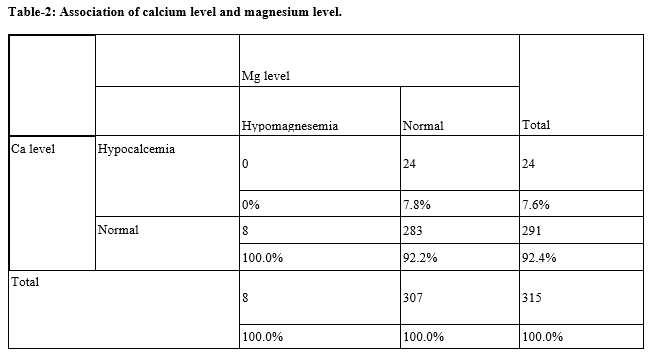Metabolic and Electrolyte profile in Birth Asphyxia
Abstract
Introduction: The definition of birth asphyxia is given by the ACOG, AAP includes the existence of 3 factors: Metabolic or mixed acidemia (pH<7) which is determined by umbilical cord arterial blood samples. The major causes of neonatal seizures are Hypoxic-ischemic encephalopathy (HIE), which represents about 50% of the causes of neonatal seizures. Metabolic abnormalities, infection, intracranial hemorrhage, developmental anomalies, and other like inborn errors of metabolism are other causes of neonatal seizures.
Material and Methods: A cross-sectional study. This is a hospital-based prospective study conducted at Nehru Hospital, BRD Medical College, Gorakhpur (UP) in the Neonatal Intensive Care Unit of the pediatric department. This study was conducted from July 2018 to July 2019.
Result: Prevalence of Hypocalcemia was 7.6%, Prevalence of hypernatremia was 1.3%, Out of 315 patients 32 (10.2%) patients expired and 283 (89.8%) was successfully discharged.
Conclusion: No association between Hypocalcemia and Hypomagnesemia Prevalence of hyponatremia was 6.3% and no association between hyponatremia and Hypomagnesemia. The prevalence of hypernatremia was 1.3% and there was no association between hypernatremia and Hypomagnesemia.
Downloads
References
Kumar A, Gupta A. Clinico-etiological and EEG profile of neonatal seizures. Indian J Pediatr. 2007;74(1):33-37. doi: 10.1007/s12098-007-0023-0.
Sood A, Grover N, Sharma R. Biochemical abnormalities in neonatal seizures. Indian J Pediatr. 2003;70(3):221-224. doi: 10.1007/BF02725588.
Aslam HM, Saleem S, Afzal R, Iqbal U, Saleem SM, Shaikh MW, et al. Risk factors of birth asphyxia. Ital J Pediatr 2014;40(1):94. doi: 10.1186/s13052-014-0094-2.
Jajoo D, Kumar A, Shankar R, Bhargana. Effect of birth asphyxia in serum Magnesium levels in neonate. Indian J Pediatr. 1995;62(4):455-459. doi: 10.1007/bf02755067.
Tekgul H, Gauvreau K, Soul J, Murphy L, Robertson R, Stewart J, Volpe J, Bourgeois B, du Plessis AJ. The current etiologic profile and neurodevelopmental outcome of seizures in term newborn infants. Pediatr. 2006;117(4):1270-1280. doi: 10.1542/peds.2005-1178.
Wani AA, Ashraf S, Gatoo IA, Abdus S. Spectrum of biochemical abnormalities in neonatal seizures at a tertiary care hospital. Int J Develop Res. 2015;5(05):4311-4315/
Arunkumar AR, VR SR, Sumathi ME. Biochemical abnormalities in neonatal seizures in a tertiary care rural teaching hospital of South India. NJBMS. 2013 Jul;4.
Madhusudhan K, Nadavapalli Suresh S, Babu TR, Rao JV, Kumar SB. Study of biochemical abnormalities in neonatal seizures with special reference to hyponatremia. Int J Contemp. Pediatr. 2016;3(3):730-734. doi: 10.18203/2349-3291.ijcp20162172.
Aziz A, Gattoo I, Aziz M, Rasool G. Clinical and etiological profile of neonatal seizures: a tertiary care hospital based study. Int J Res Med Sci. 2015;3(9):2198-2203. doi: 10.18203/2320-6012.ijrms20150601.
Nawab T, Lakshmipathy NS. Clinical profile of neonatal seizures with special reference to biochemical abnormalities. Int J Contemp Pediatr 2016;3(1):183-188. doi: 10.18203/2349-3291.ijcp20160156.
Suganthi V, Vikneshwari K, Thivya G. Prevalence of hypomagnesemia in neonatal seizures in a tertiary care hospital in South India. Pediatr Rev: Int J Pediatrics Res. 2017;4(01):64-68. doi:10.17511/ijpr.2017.01.13.
Jain A, Agarwal R, Shankar MJ, Deorari A, Paul VK. Hypocalcemia in the newborn. Indin J Pediater. 2010;77( 10):1123–8. doi: 10.1007/s12098-010-0176-0.
Nawab T, Lakshmipathy NS. Clinical profile of neonatal seizures with special reference to biochemical abnormalities. Int J Contemp Pediatr. 2016;3(1):183-188. doi: 10.18203/2349-3291.ijcp20160156.
Saha D, Ali MA, Haque MA, Ahmed MS, Sutradhar PK, Latif T, et al. Association of hypoglycemia, hypocalcemia and hypomagnesemia in neonates with perinatal asphyxia. Mymensingh Med J. 2015;24(2):244-250.
Liamis G, Liberopoulos E, Alexandridis G, Elisaf M. Hypomagnesemia in a department of internal medicine. Magnesium Res. 2012;25(4):149-158. doi:10.1684/mrh.2012.0325.
Kumar AS, Gupta VE, Kachhawaha JS, Singla PN. Biochemical abnormalities in neonatal seizures. Indian Pediatr. 1995;32(4):424-428.
Basu P, Das H, Choudhuri N. Electrolyte status in birth asphyxia. Indian J Pediatr. 2010;77(3):259-262. doi: 10.1007/s12098-010-0034-0.

Copyright (c) 2020 Author (s). Published by Siddharth Health Research and Social Welfare Society

This work is licensed under a Creative Commons Attribution 4.0 International License.


 OAI - Open Archives Initiative
OAI - Open Archives Initiative


